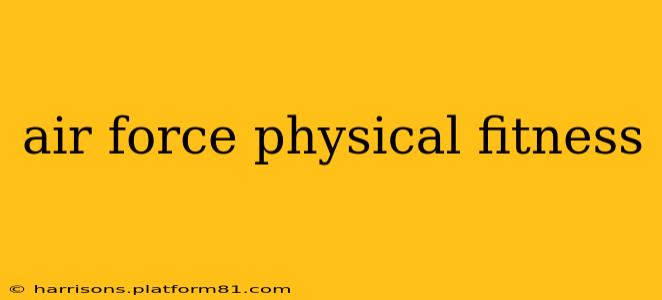The Air Force, like all branches of the military, places a strong emphasis on physical fitness. Maintaining peak physical condition is crucial for mission readiness and overall health. This comprehensive guide will delve into the specifics of Air Force physical fitness standards, training, and resources available to Airmen.
What are the Air Force Physical Fitness Standards?
The Air Force uses the Air Force Fitness Assessment (AFFA) to evaluate the physical fitness of its members. This assessment consists of three events: push-ups, sit-ups (or abdominal crunch), and a 1.5-mile run. Minimum passing scores vary depending on age and gender, and exceeding the standards leads to awards and recognition. Failure to meet the minimum standards can result in various consequences, including mandatory participation in the Health and Wellness Program. The specific scoring tables are readily available on official Air Force websites (but will not be linked here, per instructions). Knowing these standards and aiming to exceed them is key to maintaining a successful Air Force career.
What is the Air Force's Health and Wellness Program?
The Health and Wellness Program (HWP) is designed to help Airmen who don't meet the minimum fitness standards improve their physical fitness. It provides personalized fitness plans, nutritional guidance, and access to fitness resources. Participation in the HWP is mandatory for those who fail the AFFA, and successful completion is vital for retaining their position within the Air Force. The program focuses on gradual improvements, understanding individual limitations and focusing on sustainable lifestyle changes.
How Often is the Air Force Fitness Test?
Airmen are typically required to take the AFFA once a year. The exact timing and specifics might vary slightly depending on individual units and assignments, but the annual assessment is a standard part of Air Force life. Maintaining consistent fitness throughout the year is crucial for success on the test.
How Can I Prepare for the Air Force Fitness Test?
Preparing for the AFFA requires a dedicated and well-structured approach. A comprehensive training regimen should incorporate cardiovascular training (running, swimming, cycling), strength training (push-ups, sit-ups, weightlifting), and flexibility exercises (stretching, yoga). It is also essential to focus on proper nutrition and hydration to support your training and recovery. Remember to consult with a healthcare professional or fitness expert to create a personalized plan that aligns with your individual needs and fitness level. Improper training can lead to injuries, hindering your performance and progress.
What are some common Air Force fitness training programs?
Many programs are used to prepare for the AFFA. These range from individually designed plans to those offered by the Air Force itself through the HWP. These programs often incorporate interval training, circuit training, and other high-intensity methods to optimize fitness gains in a short amount of time. It's beneficial to explore the various options available to find a program that aligns with personal preferences and schedule.
What are the benefits of maintaining a high level of fitness in the Air Force?
Maintaining peak physical condition isn't just about passing the AFFA. It contributes significantly to overall health, reducing the risk of chronic diseases and improving mental well-being. It also enhances job performance, enabling Airmen to better handle the physical demands of their roles. Furthermore, a high level of fitness boosts self-confidence and resilience, essential qualities for military service.
Conclusion
The Air Force Physical Fitness Assessment is a vital component of Air Force life, emphasizing the importance of physical readiness for mission success and overall well-being. By understanding the standards, utilizing available resources, and committing to a consistent training regimen, Airmen can not only meet but exceed expectations, contributing to their own success and the strength of the Air Force.
